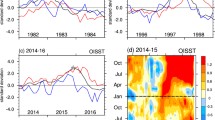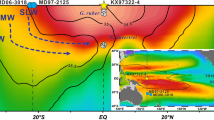Abstract
The tropical Pacific experienced a sustained warm sea surface condition that started in 2014 and a very strong El Niño event in 2015. One striking feature of this event was the horseshoe-like pattern of positive subsurface thermal anomalies that was sustained in the western-central equatorial Pacific throughout 2014–2015. Observational data and an intermediate ocean model are used to describe the sea surface temperature (SST) evolution during 2014–2015. Emphasis is placed on the processes involved in the 2015 El Niño event and their relationships with SST anomalies, including remote effects associated with the propagation and reflection of oceanic equatorial waves (as indicated in sea level (SL) signals) at the boundaries and local effects of the positive subsurface thermal anomalies. It is demonstrated that the positive subsurface thermal anomaly pattern that was sustained throughout 2014–2015 played an important role in maintaining warm SST anomalies in the equatorial Pacific. Further analyses of the SST budget revealed the dominant processes contributing to SST anomalies during 2014–2015. These analyses provide an improved understanding of the extent to which processes associated with the 2015 El Niño event are consistent with current El Niño and Southern Oscillation theories.
Similar content being viewed by others
References
Bjerknes J. 1969. Atmospheric teleconnections from the equatorial pacific. Mon Weather Rev, 97: 163–172
Chen D, Lian T, Fu C, Cane M A, Tang Y, Murtugudde R, Song X, Wu Q, Zhou L. 2015. Strong influence of westerly wind bursts on El Niño diversity. Nat Geosci, 8: 339–345
Gao C, Zhang R H. 2017. The roles of atmospheric wind and entrained water temperature (Te) in the second-year cooling of the 2010–12 La Niña event. Clim Dyn, 48: 597–617
Hu S, Fedorov A V. 2016. Exceptionally strong easterly wind burst stalling El Niño of 2014. Proc Natl Acad Sci USA, 113: 2005–2010
Jin F F, An S I. 1999. Thermocline and zonal advective feedbacks within the Equatorial ocean recharge oscillator model for ENSO. Geophys Res Lett, 26: 2989–2992
Kalnay E, Kanamitsu M, Kistler R, Collins W, Deaven D, Gandin L, Iredell M, Saha S, White G, Woollen J, Zhu Y, Leetmaa A, Reynolds R, Chelliah M, Ebisuzaki W, Higgins W, Janowiak J, Mo K C, Ropelewski C, Wang J, Jenne R, Joseph D. 1996. The NCEP/NCAR 40-year reanalysis project. Bull Amer Meteorol Soc, 77: 437–471
Keenlyside N, Kleeman R. 2002. Annual cycle of equatorial zonal currents in the Pacific. J Geophys Res, 107: 3093
Levine A F Z, McPhaden M J. 2016. How the July 2014 easterly wind burst gave the 2015-2016 El Niño a head start. Geophys Res Lett, 43: 6503–6510
Liu B Q, Li J Y, Mao J Y, Ren R C, Liu Y M. 2015. Possible mechanism for the development and suspending of El Niño event in 2014 (in Chinese). Chin Sci Bull, 60: 2136
McCreary J P. 1981. A linear stratified ocean model of the equatorial undercurrent. Philos Trans R Soc A-Math Phys Eng Sci, 298: 603–635
McPhaden M J. 2015. Playing hide and seek with El Niño. Nat Clim Change, 5: 791–795
Min Q, Su J, Zhang R, Rong X. 2015. What hindered the El Niño pattern in 2014? Geophys Res Lett, 42: 6762–6770
Reynolds R W, Smith T M. 1994. Improved global sea surface temperature analyses using optimum interpolation. J Clim, 7: 929–948
Zebiak S E, Cane M A. 1987. A model El Niñ-southern oscillation. Mon Weather Rev, 115: 2262–2278
Zhang C, Li S. 2015. Why is the El Niño event during the 2014 winter not a strong one? (in Chinese). Chin Sci Bull, 60: 1941–1951
Zhang R H, Zebiak S E, Kleeman R, Keenlyside N. 2003. A new intermediate coupled model for El Niño simulation and prediction. Geophys Res Lett, 30: 2012
Zhang R H, Kleeman R, Zebiak S E, Keenlyside N, Raynaud S. 2005. An empirical parameterization of subsurface entrainment temperature for improved SST anomaly simulations in an intermediate ocean model. J Clim, 18: 350–371
Zhang R H, Zheng F, Zhu J, Wang Z. 2013. A successful real-time forecast of the 2010–11 La Niña event. Sci Rep, 3: 1108
Zhang R H, Gao C. 2016a. Role of subsurface entrainment temperature (Te) in the onset of El Niño events, as represented in an intermediate coupled model. Clim Dyn, 46: 1417–1435
Zhang R H, Gao C. 2016b. The IOCAS intermediate coupled model (IOCAS ICM) and its real-time predictions of the 2015–2016 El Niño event. Sci Bull, 61: 1061–1070
Zhu J, Kumar A, Huang B, Balmaseda M A, Hu Z Z, Marx L, Kinter III J L. 2016. The role of off-equatorial surface temperature anomalies in the 2014 El Niño prediction. Sci Rep, 6: 19677
Acknowledgements
We would like to thank Profs. Mu Mu and Dunxin Hu for their comment. The authors wish to thank the two anonymous reviewers for their comments. This research was supported by the National Natural Science Foundation of China (Grant Nos. 41690122, 41690120, 41490644, 41490640 & 41475101), AoShan Talents Program Supported by Qingdao National Laboratory for Marine Science and Technology (Grant No. 2015ASTP), the Chinese Academy of Sciences Strategic Priority Project, the Western Pacific Ocean System (Grant Nos. XDA11010105 & XDA11020306), the National Natural Science Foundation of China-Shandong Joint Fund for Marine Science Research Centers (Grant No. U1406401), and the National Natural Science Foundation of China Innovative Group Grant (Grant No. 41421005), Taishan Scholarship and Qingdao Innovative Program (Grant No. 2014GJJS0101), China Postdoctoral Science Foundation and Qingdao Postdoctoral Application Research Project.
Author information
Authors and Affiliations
Corresponding author
Rights and permissions
About this article
Cite this article
Zhang, R., Gao, C. Processes involved in the second-year warming of the 2015 El Niño event as derived from an intermediate ocean model. Sci. China Earth Sci. 60, 1601–1613 (2017). https://doi.org/10.1007/s11430-016-0201-9
Received:
Accepted:
Published:
Issue Date:
DOI: https://doi.org/10.1007/s11430-016-0201-9




